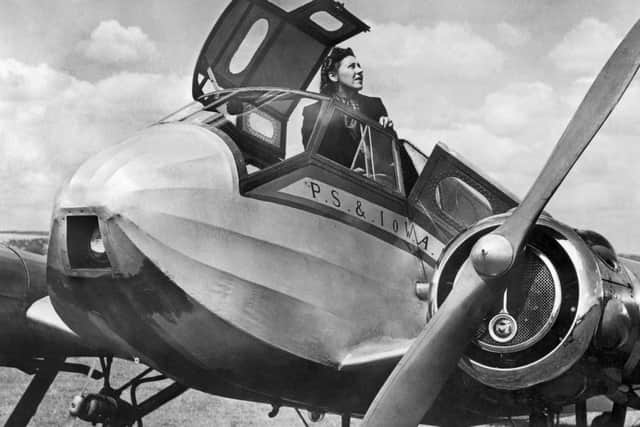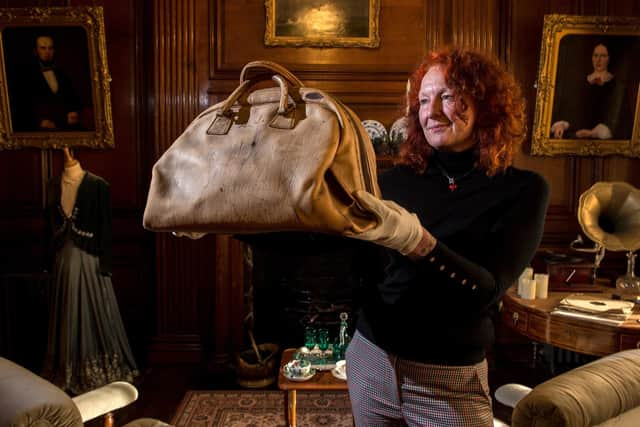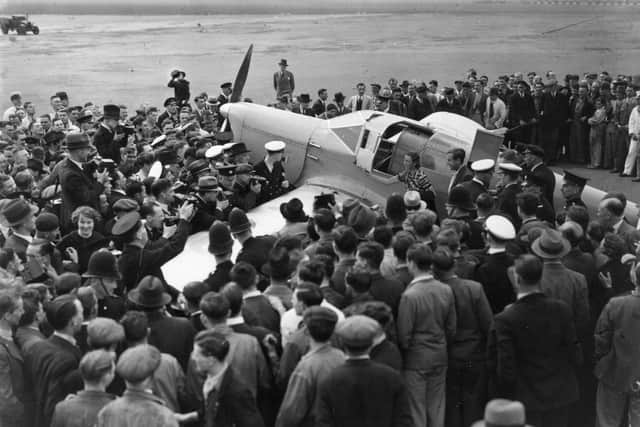Who was Amy Johnson? We look at the story of the Hull-born aviator 80 years after her tragic death
The Hull-born aviator had flown in Jason, her Gypsy Moth plane, and her audacity caught the world’s imagination. Aviation was still in its infancy and Amy – just 27 – wasn’t only a pioneering pilot, she was also a woman in what was very much a man’s world.
On her return she was laden with honours, including a CBE from King George V and gold medals from both the Royal Aero Club and the Society of Engineers.
Advertisement
Hide AdAdvertisement
Hide AdAlmost overnight she became one of the most famous women in the world, what today we might call a ‘‘celebrity superstar’’.


Though as Janice Smith, curator of the Sewerby Hall Museum near Bridlington, points out, fame back in the 1920s was not the same as it is today. “She was lauded rather differently – the song Amy, Beautiful Amy was recorded by many top bands of the time, and it was played everywhere,” says Smith.
Sewerby Hall (now a Grade I listed building) was acquired by the local town council in 1934, and when it opened as a museum two years later the ribbon was cut by (who else?), Amy Johnson.
Today, Johnson is commemorated in many ways – Hull has two statues of her, there’s the Amy Johnson Building at Sheffield University (where she studied for her degree), and there are roads, schools and an annual lecture in her name, given by a guest speaker at the Royal Aeronautical Society.
Advertisement
Hide AdAdvertisement
Hide AdAnd at Sewerby, there is an impressive collection of her belongings, and other memorabilia, much of it donated by her father, in 1958, while the Museums archive at Hull also has much material on her life and times.


Production of a biopic movie (They Flew Alone) began only weeks after her death; it starred Anna Neagle as Johnson, and was a box office smash.
But how many people today actually know who Amy Johnson was, and why she played such a significant part in aviation history?
In normal times, Sewerby Hall welcomes around 100,000 visitors every year, though not everyone goes into the museum, and that is a great shame, because they will find much to admire and to enjoy. One of the most poignant exhibits is Amy’s flying bag, containing many personal belongings.
Advertisement
Hide AdAdvertisement
Hide Ad“It was fished out of the Thames Estuary after she crashed in 1941,” says Smith. “It’s such an intimate object and it went with her wherever she went.”


Another of the items at Sewerby is her flying log book. “Again this is very personal but almost indecipherable – she had appalling handwriting, and it is very hard to make out what the scrawl says.”
Johnson herself was the eldest of four girls – her sister Betty was born 16 years later. She had a comfortable, middle class background. Her family obviously had a sense of civic duty – her mother’s grandfather had been the first Sheriff of Hull, then the city’s Lord Mayor, and after
that, an Alderman.
Johnson’s father had set up his own fish merchant business, Andrew Johnson and Knudtzon. It prospered and the family moved several times, finally settling in Bridlington.
Advertisement
Hide AdAdvertisement
Hide AdAmy moved to London where she worked as a secretary for a firm of solicitors. And it was here that she discovered flying.
She went to the London Aeroplane Club at Stag Lane in Edgware, housed at a small airstrip owned by the prestigious de Havilland plane-makers, and quickly developed a passion for flying, encouraged by her mentor, Captain Valentine Baker. Baker was one of the very few who had, during the First World War, served in each branch of the armed services. He was one of the most noted (and fearless) airmen of the day.
Amy paid for every lesson out of her own pocket. She studied hard and in July 1929, she became one of the first women to gain a pilot’s licence. She wrote to her parents, telling them that she had a belief in the future of global aeronautics, and then she handed in her notice at the solicitor’s firm.
She joined the ground team at Stag Lane working as a mechanic and later that year she had achieved her Ground Engineer’s Licence, granted by an incredulous Air Ministry – Amy was the first female in the world to be given this coveted qualification.
Advertisement
Hide AdAdvertisement
Hide AdShe was a fully-fledged aviatrix, the new word coined for female fliers, and she was looking for adventures. So in May 1930 she set off on her epic flight from Croydon Aerodrome flying Jason – not named after the voyager of legend, as many believed, but a contraction of the trademark used by her father’s business back in Hull.
She flew off from Surrey on May 5, and, after flying 11,000 miles, arrived in Darwin, in Australia, on May 24. Jason can still be seen today – the plane is one of the much-prized exhibits of the Science Museum of Australia.
It was an astonishing feat and Australia marked her success by awarding her their own pilot’s licence – she was the first woman in the country to get it.
Back in London she was awarded the Harmon Trophy awarded annually to the world’s outstanding aviator, aviatrix, and aeronaut.
Advertisement
Hide AdAdvertisement
Hide AdShe was greeted by cheering crowds wherever she went, something she found uncomfortable – she was far happier in her cockpit than addressing meetings or hobnobbing at cocktail parties.
So off she went with her co-pilot Jack Humphreys (this time in a Puss Moth called Jason II) to see if they could get to Moscow in a day. They did, in just 21 hours. Another first. They continued on to Tokyo, setting more records.
Britain was gripped by ‘‘Amy fever’’ and in 1932 the nation’s heroine met and quickly married a fellow pilot called Jim Mollison. Johnson made further flights to the United States, India and South Africa. In the air she was unstoppable, but her marriage ended in divorce in 1938.
With the outbreak of war, she applied for combat duties and to her disappointment (and anger) the RAF turned her down. She joined the ATA (Air Transport Auxiliary) instead.
Advertisement
Hide AdAdvertisement
Hide AdThe ATA flew new planes to bases all over Britain and Johnson was made a First Officer, and flew a series of successful missions. However, her luck ran out on January 5, 1941. She was flying an Airspeed Oxford from Blackpool to RAF Kidlington (near Oxford), and the wintry conditions deteriorated so badly that she ended up way off course and (it is assumed) ran out of fuel out over the Thames estuary.
The plane went into the icy waters, but the crew of HMS Haslemere had seen a parachute descending and then someone floundering. Snow was falling, visibility very poor, the seas were high and the tide fast-running. Lt Commander Walter Fletcher, dived in to the rescue, but tragically he drowned, later receiving a posthumous Albert Medal.
Despite a diligent search, Amy’s body was never found. Some claim that she had a high-ranking passenger on board, and that the identity of that person was never to be revealed, others suggest the propellers of a rescue boat that went to assist the gallant commander hit Amy and killed her.
There is another theory that her plane was shot down by ‘‘friendly fire’’ – from a gun battery near the Thames. “I’m with this version”, says Janice Smith. “It seems the most likely, and it was such an avoidable tragedy”. Shelling started because she apparently gave incorrect code words after the battery made radio contact.
Advertisement
Hide AdAdvertisement
Hide AdYears later, some human bones were washed up on the estuary coastline. The belief was that they were hers, but subsequent tests showed they were not.
But while the mystery surrounding the exact circumstances of her death remains unsolved, her legacy as a pioneering Yorkshire icon is undiminished.